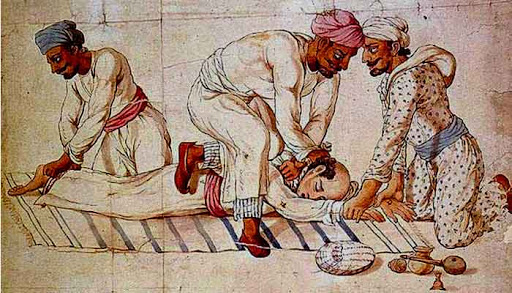Nothing says law-and-order like thug. Once again, the word is being bandied about in all the media. The thugs are out looting and rioting in the inner cities of America, we are told. Every time protests against police brutality ignite across the United States out comes the word from some all-too-convenient grab box of insults. Opinion pieces are full of it, and so are the mouths of politicians.
Certainly, there has been violence and destruction of businesses amidst the largely peaceful protests following the horrific murder of George Floyd. We can all agree the wanton destruction of shops owned by innocent community members, often black or brown themselves, is simply wrong. There can be no defense of such actions. But does it help to call the people involved thugs? Is the word at all illuminating in thinking about the events of the last few days? Or does it rather—by design—obscure more than it reveals?
Thug is by now a fully American word, but it wasn’t always. As the screenshot below suggests, thug, facilitated by British colonialism, entered the English language in early 19th century India, probably from Hindi or Hindustani.

Screenshot of an online dictionary no doubt—but the “historical” definition offered above is surely wrong. I have written before in this blog (and more fully in the critical essay “Thugs and Bandits”) about why. And others have too, in postcolonial scholarship that is by now at least forty years old. Today, scholarly consensus holds that the word thug is profoundly shaped by (willful) British colonialist misconceptions of India.
A religious organization? Devotees of Kali? Ritually prescribed strangulation? All of this is likely pure fabrication. Were there robbers who waylaid and murdered travelers in the midst of the social chaos of early 19th century India? Surely. But the British loudly and ceaselessly claimed more, much more—that thugs were nothing less than fiendish members of a vast and ancient demonic cult called thuggee. Why?

In the early 19th century, British colonialism was rapidly advancing across India. It needed a reason to extend its rule into new territories. Enter thuggee. The wild and diabolical stories of thuggee invented by the British provided justification for them to displace native Indian rulers, seen as either unable to control thuggee or else going further to abet and give it protection. In place of native rulers, the British established their own rule.
The British discourse around thuggee in the 19th century aimed to convert a complex, social story of human beings struggling with social chaos and economic dislocation into a narrative justification for iron-fisted rule. It did so in two parts. First, it converted specific human beings, all robbers no doubt and many murderers, into demonic thugs, that is, targets for the most extreme disciplinary action. Then, it made thugs representative of Indians in general and thus made India as such a target for disciplinary action. It was a discourse masterfully designed to create a maximally repressive, law-and-order colonial state.
Fast forward to the US today. Does the word thug not do similar work now? Does it not parallel British colonial discourse in 19th century India in flattening out complex histories of racism, discrimination against black people and relentless police brutality against black men into a law-and-order problem? Does it not prevent us from engaging fully the real origins of the profound rage being expressed by black and other communities?
As an English word, thug originates in a law-and-order mentality and it continues to express such a mentality today. Rather than fostering understanding and engagement, it propagates the iron fist of draconian rule. Like British discourse on thuggee in the 19th century, the use of the American incarnation of the word today justifies the reduction of a social crisis to a law-and-order problem—a problem to be met by the force of the carceral state about which, alas, black communities know only too much.
